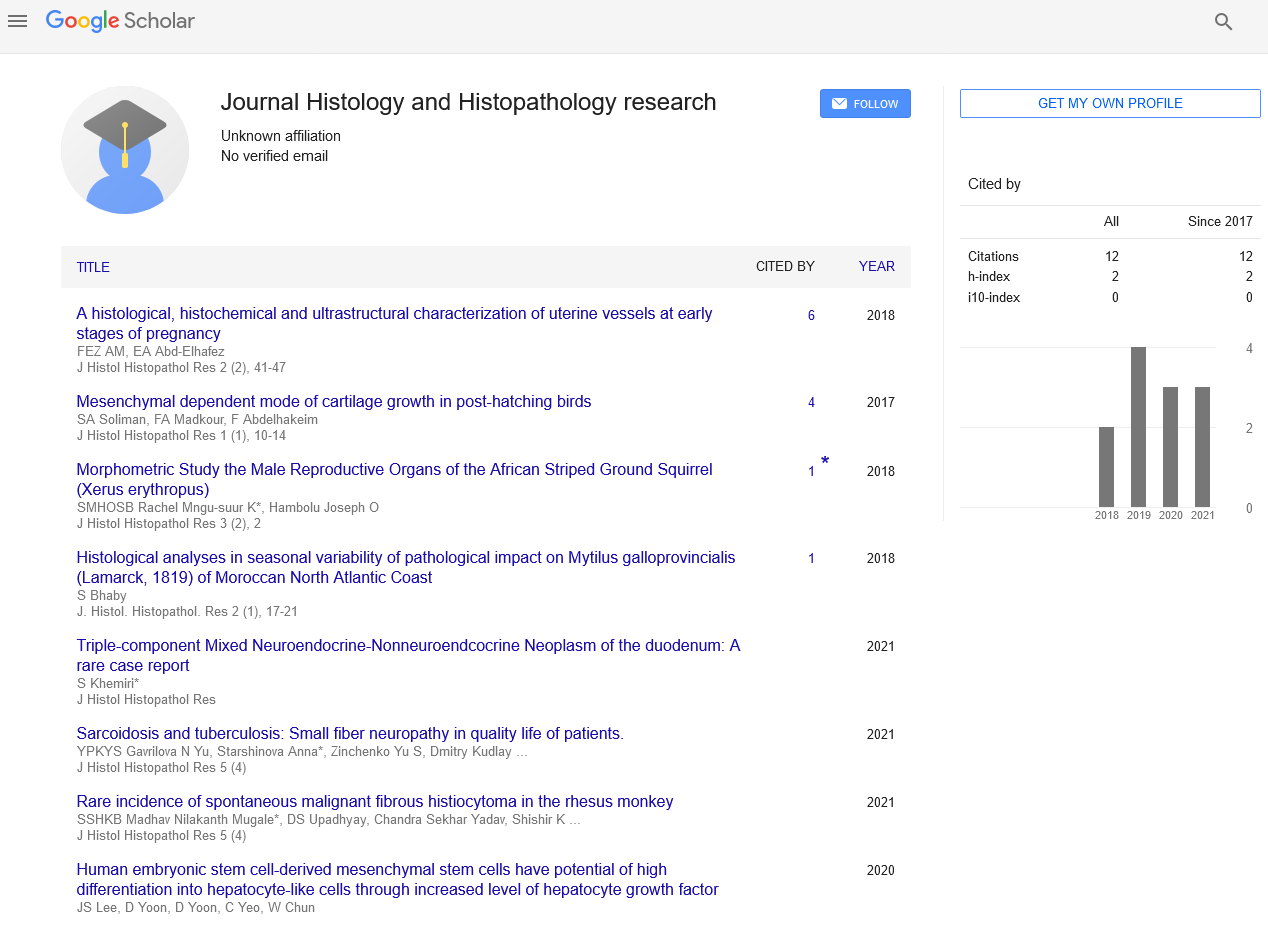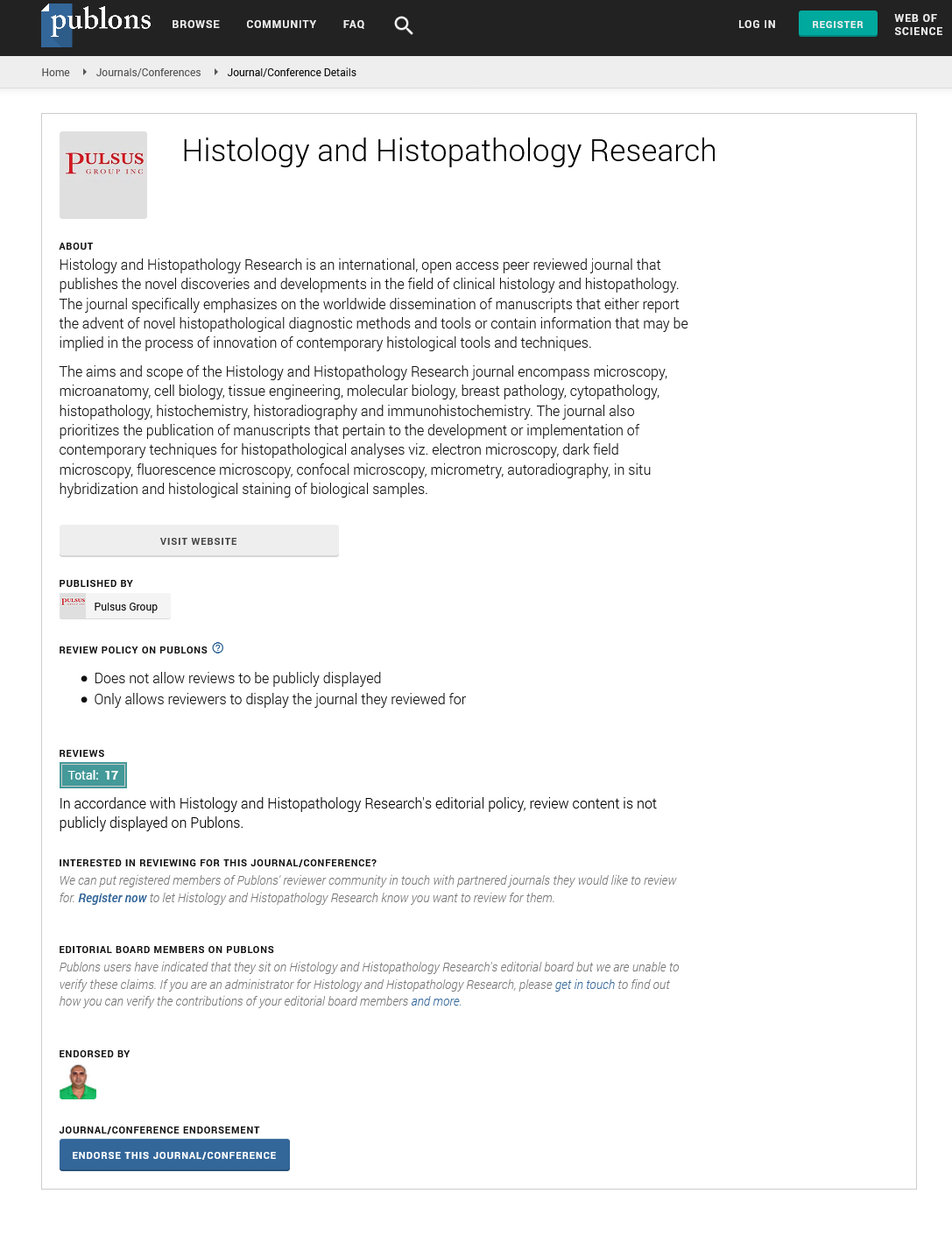Histopathological features that are more useful in diagnosing the stages of kaposi sarcoma
Received: 04-May-2022, Manuscript No. PULHHR-22-5089; Editor assigned: 06-May-2022, Pre QC No. PULHHR-22-5089 (PQ); Accepted Date: May 20, 2022; Reviewed: 17-May-2022 QC No. PULHHR-22-5089 (Q); Revised: 19-May-2022, Manuscript No. PULHHR-22-5089 (R); Published: 26-May-2022, DOI: 10.37532/pulhhr.22.6(3).68-69
Citation: James R. Histopathological features that are more useful in diagnosing the stages of Kaposi sarcoma. J Histol Histopathol Res. 2022;6(3):68-69.
This open-access article is distributed under the terms of the Creative Commons Attribution Non-Commercial License (CC BY-NC) (http://creativecommons.org/licenses/by-nc/4.0/), which permits reuse, distribution and reproduction of the article, provided that the original work is properly cited and the reuse is restricted to noncommercial purposes. For commercial reuse, contact reprints@pulsus.com
Abstract
Kaposi Sarcoma (KS) is a locally aggressive angioproliferative tumour with varied histological characteristics at different stages. Histopathological findings have diagnostic relevance depending on the stage, frequency, and kind of abnormalities reported. The study’s goal was to establish a finding or a combination of results that are prevalent in different phases of KS and can successfully identify that stage.
The Human Herpesvirus 8 (HHV-8) virus, a member of the gammaherpesvirus subfamily, is involved in the development of Kaposi Sarcoma (KS). Moritz Kaposi, a Hungarian dermatologist, was the first to characterize it as a “idiopathic numerous pigmented sarcoma of the skin” in 1872. KS is a locally aggressive tumour with a low malignancy potential that progresses through patch, plaque and nodular phases. Significant histological characteristics are predominant at each stage, posing different problems in histopathological diagnosis and differential diagnosis. These diagnostic challenges include benign or reactive lesions in the patch stage, as well as other vascular sarcomas or cutaneous spindle cell tumours in the nodule stage.
Keywords
Kaposi Sarcoma (KS); Histopathological; Patients
Introduction
Kaposi Sarcoma (KS) is a locally aggressive angioproliferative tumour with varied histological characteristics at different stages. Histopathological findings have diagnostic relevance depending on the stage, frequency, and kind of abnormalities reported. The study’s goal was to establish a finding or a combination of results that are prevalent in different phases of KS and can successfully identify that stage [1].
The Human Herpesvirus 8 (HHV-8) virus, a member of the gammaherpesvirus subfamily, is involved in the development of Kaposi Sarcoma (KS). Moritz Kaposi, a Hungarian dermatologist, was the first to characterize it as an “idiopathic numerous pigmented sarcoma of the skin” in 1872. KS is a locally aggressive tumour with a low malignancy potential that progresses through the patch, plaque, and nodular phases. Significant histological characteristics are predominant at each stage, posing different problems in histopathological diagnosis and differential diagnosis. These diagnostic challenges include benign or reactive lesions in the patch stage, as well as other vascular sarcomas or cutaneous spindle cell tumours in the nodule stage.
As a result, it is critical to establish accurate and reliable histopathological diagnostic characteristics for each stage of KS. In our case series, we looked at the histopathological findings utilised in the diagnosis of KS. The study’s goal was to uncover a finding or a collection of results that are prevalent in each stage of KS and may successfully identify a certain stage of KS.
The histological characteristics of 121 Kaposi sarcoma patients were reviewed and reevaluated retrospectively [2]. Two pathologists independently evaluated the histopathological sections for the presence, absence, and frequency of the following features: stage, hyperkeratosis, acanthosis, ulceration, presence of spindle cells, fascicle formation, cleft-like space, horizontally oriented vascular bundles, large vessels in the periphery, “promontory” sign, nodule formation, hyaline globules, extravasated erythrocytes, hemo (lymphocyte, plasma cell or neutrophil). Furthermore, the link between morphological features and illness stage was investigated. For qualitative assessments, minimum, median, and maximum values were employed, while numbers and percentages were used for quantitative evaluations. The Pearson Chi-square test and multivariate regression analysis were utilised for comparative studies. p<0.05 was judged statistically significant [3].
Kaposi sarcoma is a multicentric angioproliferative spindle cell tumour with histopathological and clinical heterogeneity that develops from endothelial cells. Multiple lesions in the lower extremities are seen in males in their sixth and seventh decades. Our case series’ demographic characteristics were found to be consistent with the literature.
Previous research has found a nodular stage incidence of 36-87.5%. The nodular stage was the most prevalent in our research (67.8%). Alternatively, several investigations have found that the plaque stage is the most prevalent in HIV-positive KS patients. The nodular stage was prevalent in our HIVpositive individuals, however, all patients’ serological data could not be retrieved.
Although not specific, hyaline globules, which are erythrocytic degradation product repositories, are thought to have diagnostic value in Kaposi sarcoma. The most prevalent histological characteristic detected in this investigation was erythrocyte extravasation (98.3%), while hyaline globules were seen in the cellular cytoplasm or extracellular matrix in 95% of patients. The occurrences of hyperkeratosis, acanthosis, ulceration, spindle cell presence, fascicles, cleft-like space, horizontally oriented vascular bundles, hemosiderin, big vessels at the tumours perimeter, nodule, globule, atypia, mitosis, and necrosis varied significantly across phases [4].
Intersecting, bundled spindle cells and erythrocyte-containing clefts that separate vascular structures are seen in the characteristic nodular stage of KS. In transverse slices, the spindle cells resemble a honeycomb or sieve. Inflammatory cells (lymphocytes and plasma cells), hemosiderin accumulations, and dilated arteries are seen on the perimeter of the nodular lesion. Hyaline globules are another distinguishing but non-specific feature of lesions at this stage. Some lesions may have dilated vascular spaces akin to a cavernous hemangioma. In this stage, the massive cutaneous nodules might ulcerate, and the tumour may show cellular pleomorphism, necrosis, and mitotic figures. In our investigation, the most prevalent histological findings in patients detected in the nodular stage were inflammation, globules, erythrocyte extravasation and spindle cells.
The most effective histopathological parameters are the presence of hemosiderin, horizontal placement of vascular structures, erythrocyte extravasation and promontory findings in the patch stage; promontory, globule, and hemosiderin in the plaque stage and an ulcer, necrosis, atypia and mitosis in the nodular stage [5].
The demographic data and distribution of histopathological findings by stage in this retrospective analysis of KS were comparable to those published in the literature. When the histological finding that is most evident at a certain stage and best represents that stage is assessed, the diagnosis of KS which has distinct histopathological findings at different stages) may be made more firmly. Furthermore, developing a grading system with a larger number of examples would be more difficult.
REFERENCES
- Arruda E, Dos Anjos Jacome AA, de Castro Conde Toscano AL, et al. Consensus of the brazilian society of infectious diseases and brazilian society of clinical oncology on the management and treatment of kaposi's sarcoma. Braz J Infect Dis. 2014;18(3):315-326.
- Grayson W, Pantanowitz L. Histological variants of cutaneous kaposi sarcoma. Diagn Pathol. 2008;3:31.
- Kamyab K, Ehsani AH, Azizpour A, et al. Demographic and histopathologic study of kaposi's sarcoma in a dermatology clinic in the years of 2006 to 2011. Acta Med Iran. 2014;52(5):381-384.
- Errihani H, Berrada N, Raissouni S, et al. Classic kaposi's sarcoma in morocco: clinico-epidemiological study at the national institute of oncology. BMC Dermatol 2011;11:15.
- Mandong BM, Chirdan LB, Anyebe AO, et al. Histopathological study of kaposi’s sarcoma in JOS: A 16-year review. Ann Afr Med. 2004;3(4): 174–176.






